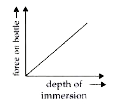Boojho took an empty plastic bottle, turned it upside down and dipped its open mouth into a bucket filled with water. He then tilted the bottle slightly and made the following observations.
(i) Bubbles of air came out from the bottle
(ii) Some water entered the bottle.
(iii) Nitrogen gas came out in the form of bubbles and oxygen got dissolved in water.
No bubbles formed, only water entered the bottle.
Which observations is/are correct?
(i) and (ii)
(iv) only
(iii) and (iv)
(i) only
The correct Answer is:A
Step by step video & image solution for Boojho took an empty plastic bottle, turned it upside down and dipped its open mouth into a bucket filled with water. He then tilted the bottle slightly and made the following observations. (i) Bubbles of air came out from the bottle (ii) Some water entered the bottle. (iii) Nitrogen gas came out in the form of bubbles and oxygen got dissolved in water. No bubbles formed, only water entered the bottle. Which observations is/are correct? by Chemistry experts to help you in doubts & scoring excellent marks in Class 6 exams.
Updated on:21/07/2023Topper's Solved these Questions
- AIR AROUND USBOOK - NCERT EXEMPLARCHAPTER - AIR AROUND USEXERCISE - VERY SHORT ANSWER QUESTIONS
7 Videos
- AIR AROUND USBOOK - NCERT EXEMPLARCHAPTER - AIR AROUND USEXERCISE - SHORT ANSWER QUESTIONS
4 Videos
- FIBRE TO FABRICBOOK - NCERT EXEMPLARCHAPTER - FIBRE TO FABRICEXERCISE - LONG ANSWER QUESTIONS
2 Videos
Similar Questions
Knowledge Check
An empty plastic bottle closed with an airtight stopper is pushed down into a bucket filled with water. As the bottle is pushed down, there is an increasing force on the bottom as shown in graph . This is because
 Amore volume of liquid is displacedBmore weight of liquid is displacedCpressure increases with depthDall of the above .
Amore volume of liquid is displacedBmore weight of liquid is displacedCpressure increases with depthDall of the above .In hot water bottles, water is used because
Aits specific heat is lowBits specific heat is highCit is cheapDit is easily availableWhen a bottle of cold drink is opened, the gas comes out with a fizzle due to:
Adecrease in pressure suddenly which results in a decrease in solubility of CO2 gas in water.Bdecrease in temperatureCincrease in pressureDnone of these
A soda water bottele is falling freely . Will the bubbles of gas rise in the water of the bottle ?
View SolutionThe mass of a bottle filled with water is found to be 150 g. the mass of the empty bottle is 50 g and the external volume of the container is 125 cm3. Find out the density of the material of the bottle.
View SolutionA dried scooped out gourd can be used as a______water bottle.
View SolutionWhen hot water is placed into an empty water bottle, the bottle keeps its shape and does not soften. What type of plastic is the water bottle made from?
View SolutionWhen we open soda water bottle, a fizz sound is heard
View Solution